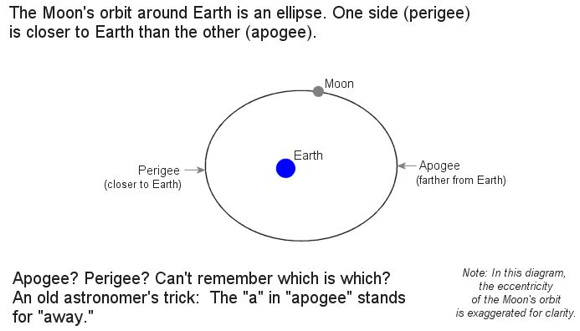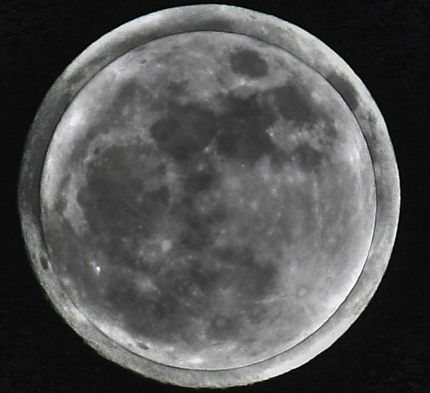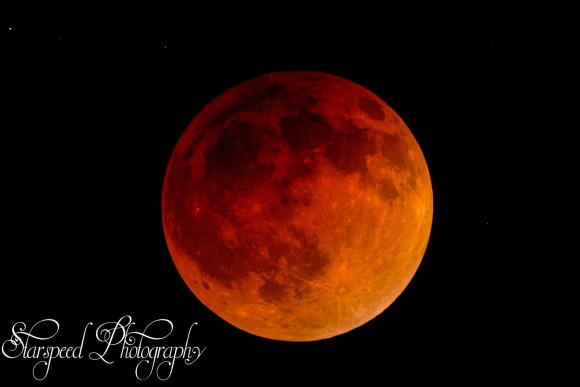An astrologer, Richard Nolle, is credited for coining the term supermoon, which has now become so widely used. He defines a supermoon as:
… a new or full moon which occurs with the moon at or near (within 90% of) its closest approach to Earth in a given orbit.
Based on this definition, should the October 8, 2014 full moon be regarded as a supermoon? Nolle and a well known astronomer, Fred Espenak, disagree. You’re likely to see all sorts of conflicting information about it, come October. Follow the links below to learn more.
How many supermoons in 2014? Commentators disagree
Original definition of supermoon
Nolle’s 90% based on 2014’s closest perigee and farthest apogee
Espenak’s 90% based on perigee and apogee of each month’s orbit
October 2014 full moon’s distance relative to 2014’s closest perigee / farthest apogee
Is October 8 moon a supermoon? Depends on which perigee/apogee distances you choose
A super Hunter’s Blood Moon in eclipse?

How many supermoons in 2014? Commentators disagree. Richard Nolle coined the term supermoon and supplied the original supermoon definition. Fred Espenak‘s career as a NASA astrophysicist at Goddard Space Flight Center spanned more than 30 years; he’s best known and loved as NASA’s eclipse expert (Mr. Eclipse).
The supermoon definition, as it stands, comes with some ambiguity. That’s why at least two commentators – and likely, soon, many more – give two different answers for the number of supermoons this year.
We refer you to two different supermoon tables for the 21st century (2001 to 2100). Here is Richard Nolle’s table, and here is Fred Espenak’s table.
In the year 2014, Richard Nolle lists three full supermoons (July, August and September 2014 full moons).
Meanwhile, Fred Espenak lists five full supermoons (June, July, August, September and October 2014 full moons).
Why are their lists so different?

Original definition of supermoon. Supermoons are based on lunar perigee (moon’s closest point to Earth for the month) and apogee (moon’s farthest point from Earth for the month). Remember, Nolle originally defined a supermoon as:
… a new or full moon which occurs with the moon at or near (within 90% of) its closest approach to Earth in a given orbit.
Each month, the moon comes closest to Earth at perigee and swings farthest away at apogee. If a new or full moon aligns with apogee, then it’s at 0% of its closest approach to Earth. On the other hand, if a new or full moon aligns with perigee, then it’s at 100% of its closest approach to Earth. That’s something we can all agree on.
But the phrase 90% of perigee is ambiguous. Read on.

Nolle’s 90% based on 2014’s closest perigee and farthest apogee. Looking at Richard Nolle’s list for all the supermoons in the 21st century, it appears that Richard Nolle bases his 90% figure on the year’s closest perigee and farthest apogee. Take the year 2014, for instance, whereby any new or full moon coming closer than 361,863.1 km qualifies as a supermoon.
This year, in 2014, the moon comes closest to Earth on August 10 (356,896 kilometers), and swings farthest away some two weeks before, on July 28 (406,567 kilometers). That’s a difference of 49,671 km (406,567 – 356,896 = 49,671 km). Ninety percent of this 49,671-figure equals 44,703.9 kilometers (0.9 x 49,671 = 44,703.9). Presumably, any new or full moon coming closer than 361,863.1 kilometers (406,567 – 44,703.9 = 361,863.1) would be “at or near (within 90% of) its closest approach to Earth.”
Farthest apogee (2014): 406,567 km
Closest perigee (2014): 356,896 km
Difference: 49,671 km
90% x 49,671 = 44,703.9 km
406,567 – 44,703.9 = 361,863.1 km = 90% of moon’s closest distance to Earth
Thus, figuring out “90% of the moon’s closest approach to Earth” by the year’s closest perigee and farthest apogee, any new or full moon swinging closer than 361,863.1 km to Earth in 2014 counts as a supermoon.
Since the full moon on October 8, 2014 only comes within 365,659 km of Earth, it doesn’t count as a supermoon on Richard Nolle’s list.

Espenak’s 90% based on perigee and apogee of each month’s orbit. Ironically, Fred Espenak’s full supermoon list might more strictly adhere to Richard Nolle’s definition (at least as it is written) than Richard Nolle himself does.
Once again, Richard Nolle describes a supermoon as:
… a new or full moon which occurs with the Moon at or near (within 90% of) its closest approach to Earth in a given orbit.
If given orbit can be taken to mean current monthly orbit, then the October 2014 full moon comes to within 92.5% of its closest approach to Earth relative to the October 2014 perigee and apogee.
October 2014 apogee: 404,897 km
October 2014 perigee: 362,476 km
Difference: 42,421 km
October 2014 apogee: 404,897 km
October 2014 full moon: 365,659 km
Difference: 39,236 km
39,235/42,421 = 0.9249 (92.49%) = distance of the October 2014 full moon relative to the October 2014 perigee and apogee
Depending on what meaning we give to the words in a given orbit, we could say the October 2014 apogee = 0% of the moon’s closest approach to Earth for October 2014, and the October 2014 perigee = 100% of the moon’s closest approach to Earth for October 2014.
That being the case, then the October 2014 full moon comes to within 92.5% of its closest approach to Earth for the month of October 2014: 39,235/42,421 = 0.9249 = 92.49%

October 2014 full moon’s distance relative to 2014’s closest perigee / farthest apogee. However, if we compute the percentage distance of the October 2014 full moon relative to the year’s farthest apogee and closest perigee, then the October full moon only comes to within 82.36% of its closest approach to Earth:
Farthest apogee (2014): 406,567 km
Closest perigee (2014): 356,896 km
Difference: 49,671 km
Farthest apogee (2014): 406,567 km
October 2014 full moon: 365,659 km
Difference: 40,908 km
40,908/49,671 = 0.8236 (82.36%) = distance of the October 2014 full moon relative to the year’s farthest apogee and closest perigee

Is October 8 moon a supermoon? Depends on which perigee/apogee distances you choose. The moon’s monthly perigee and apogee distances vary throughout the year, so it appears that the limiting distance for the supermoon depends on which perigee and apogee distances are being used to compute 90% of the moon’s closest approach to Earth.
If we choose the year’s closest perigee and farthest apogee, as Nolle did, we narrow the definition of supermoon
If we choose the perigee and apogee for a given monthly orbit, as Espenak did, then we broaden the definition of supermoon.
Given the narrower definition, the full moon on October 8, 2014 is not a supermoon, but given the broader one, it is.
Take your choice!

A super Hunter’s Blood Moon in eclipse? By the way, the October 8 full moon already has a several more names attached to it.
It’s the full moon after the September 8-9 Harvest Moon, and, as such, the full moon visible to people around the world on the night of October 7-8 will carry the name Hunter’s Moon in the Northern Hemisphere.
There will be a total lunar eclipse, visible from N. America. Click here for more info on the October 7-8 lunar eclipse.
It’s the second Blood Moon eclipse in a series of four. What’s a Blood Moon? Click here for information about Blood Moons.
So, if you choose Espenak’s definition and call the October 7-8 full moon a supermoon, then it must be a super Hunter’s Blood Moon in eclipse! Phew! What a night.
Bottom line: At least two commentators – Richard Nolle and Fred Espenak – disagree on whether the October 8, 2014 full moon should be called a supermoon. Is it? You’re likely to see all sorts of conflicting information in October, 2014. If you define a supermoon based on the year’s closest perigee and farthest apogee, then the October 8 moon is not a supermoon. If you define a supermoon based on the perigee and apogee for a given monthly orbit, then it is a supermoon. And not just any supermoon, but a super Hunter’s Blood Moon in eclipse!











